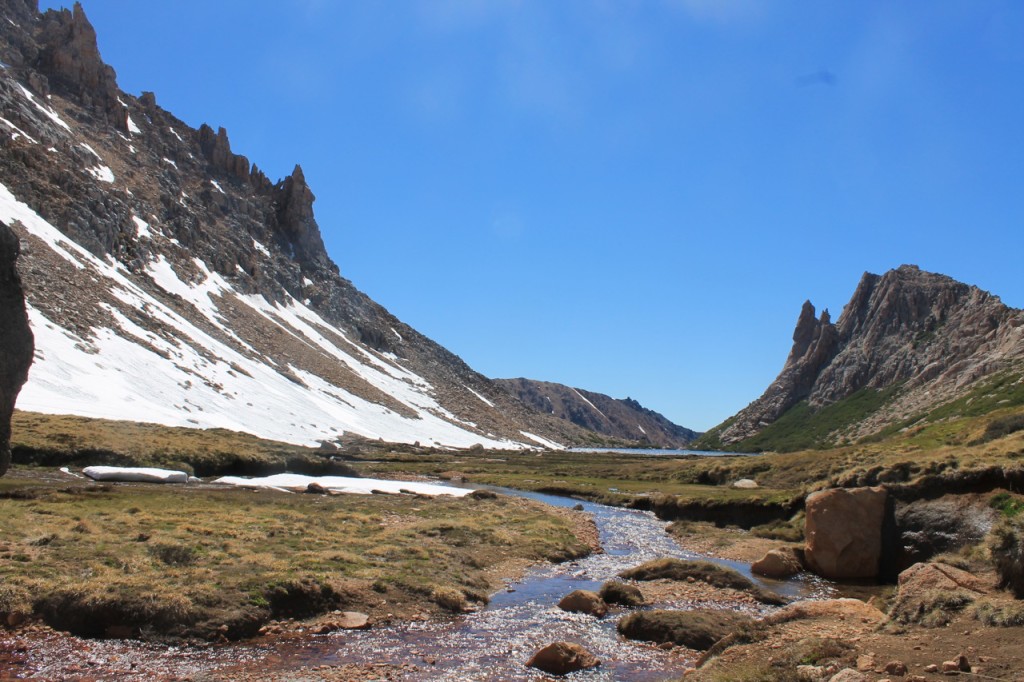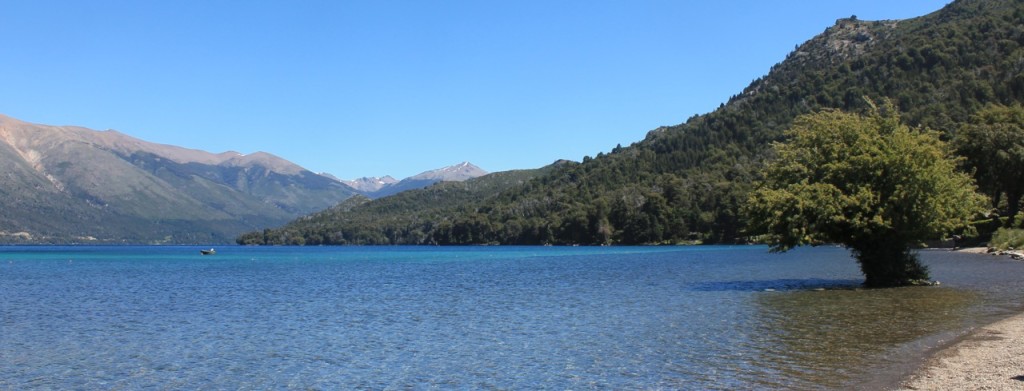Written December 2014.
Before arriving I wasn’t sure what I’d make of Barilcohe. The guidebooks continuously refer to it as the Switzerland of Argentina. Amongst the lakes and low lying mountains, the postcard of Bariloche is wooden lodges and pine trees. It claims to create the best chocolate of south america too. And if that wasn’t enough, there’s even a Swiss colony a couple of miles out of town. Unlike Switzerland, however, this colony doesn’t run to clockwork punctuality. There famous market stews are typically hours later than the time advertised. Suitably Argentinian.
But south american time is now very much ingrained with (family and colleagues might argue that it’s always been so!), so maybe this isn’t difference enough from the Europe I know. I find that I crave the new and interesting when I travel, and after more than four months and five countries, the unique is proving harder to find. One of the reasons I didn’t fall for Buenos Aires on my first visit was that much of it was uniform, not so unlike other cities that I know. Was Bariloche going to be more of the same?
With the company of Jack and Piel, a Brit and Dane I met on the bus from Mendoza, we took to the circuito chico on the first full day. It’s a 30km bike ride around the hills, lakes, and beaches close to town. It’s the top of the lonely planets list of activities for the area , which explains the feeling of being on a charity bike ride. We were part of an army of orange safety vested cyclists, all on bikes from the same rental shop. Not exactly of the beaten track, but it made for some nice comradery. Plenty of people to chat to on the ride around. The ride had some tough spots too. Tour de France style gentle and sustained inclines. A pause to catch your breath was always warranted at the top of a hill. Following the ride we hiked up the hill of Cerro Campanario. Legs of lead by the end of it all, but a great spot for a beer. I’m told that the National Geographic puts this as one of the best views in the world. Who cares if it looks a little bit like Switzerland. The scenery was stunning.
But it was two mornings later that this part of Argentina really wowed me. I’d set of solo, 1.5km higher in the sky. From Refugio Frey (a great mountain lodge run by Club Andino Bariloche), I’d been directed towards a trail that would take me back towards the city. A route that rose a few hundred meetings up snowy slopes, skirted along a mountain ridge, and ultimately wound back down.
From these slopes a collection of small tributaries grew into a mountain laguna. Deeper blue than the piercingly clear sky. I was stepping over the initial paths of snow melt – the very sources of many of the worlds rivers! They then spilled down the mountain side as a river, before helping to fill Guiterrez and the enormous Nahuel Huapi lake below. From the unfamiliar to the familiar. Snow melt to a picture postcard lakes. It’s incredible how such small streams of water build into something so much grander.
When I started hiking up the slopes it was clear my shoes were no longer up for the challenge. Trusty footwear that had taken me across three continents was now in retirement. With worn out grip, all they wanted was lazy sea level strolls. But I’d forced them this far – you try your luck when you’re traveling. The snow had become ice, and to climb upwards I found myself stepping into the frozen footsteps of those that had come before me. I don’t even mean this metaphorically. Stepping into these old footprints was the only way I could retain footing. This worked well until about half way up, where the footsteps shallowed. Eyes upwards, there was still 50m of ice above me. Red marker dots in the rocks ahead teasing me with the trail I couldn’t follow. A fools errand. I had to turn around to cautiously take the route down. Gravity had other ideas.
Within a moment I was on my arse, picking up momentum. As a kid I needed a sledge to do this. Turns out on ice you need nothing on the sort. Feet and arms flailing around on the ice to keep a vague sense of direction, I’d given up on breaks. In a movie the hero hurtles like this towards a sheer drop, grabbing hold of the edge just in time. I’m realising that this would be very hard to do in practice. Thankfully, here, the slope gently levels out. I stop naturally. OK. Just an ice burn on my back and hands totally numb of feeling.
It took more than half an hour for the feeling to fully return to my hands. Much of this with one hand or the other wedged within the sleeve of my jumper for extra warmth. Blood gradually prickling back to the surface, a little painfully. It was an immensely satisfying feeling. A little shaken and stirred I tried to come up with a life lesson for my encounter with the enormity of nature: always wear sensible footwear; or ice is for my cocktails, not for walking upon.
I instead hiked the return the way I’d arrived. Past refugio Frey, which at this time of day was a climbers haven. Some would rest in the sun. Others would take to the spires of the granite rocks. Yellow and white helmets visible from a distance, positions maintained by hands clasped into finger cracks. They tell me that this rock is perfect with routes from novice to expert. It was then down through a quaint mountainside forest and onwards towards the lakes. I’d hiked up with others, but was solo on the way down. Time to breath. Time to think. Time to swat a greater number of giant flies away now I was their only target.
At the bottom of the trail, I sat. On the shore of lake Guitierez the serenity of the scene was in stunning contrast to the mountains above. Just a few hours earlier I was utterly failing to conquer the icy heights where this very lake began. Now I was hearing small waves gently lap against the shore. And around me a forest of lush green, hiding sedate paths and private wooden lodges. I get caught up enough in the scene to miss the first passing bus back to town. No rush.
That night I found myself chatting to strangers in Manush bar, the closest I’ve found to a true quality British style pub on the continent. It has a great selection of ales and a crowded atmosphere that funnels people towards the bar. This was rounded up by morcilla (blood sausage) and de chorizo (sirloin steak) at Alberto’s restaurant, washed down with a deliciously cheap quality bottle of red wine. Arguably the best steak in down. Even the stray dogs were lining up at the door in an attempt to get in on the action. After three full days of exertion, I’m not sure I’ve ever craved such a giant slap of meat before. The taste lived up to its reputation.
The next day I’d jump on a bus further south. More than 24hrs and 2,000km to El Calafate. A town situated on the edge of the glaciar park of southern Patgonia. From here, I’d find myself trekking across Perito Modeno glaciar. Just this time complete with the heavy tred of crampons. Gravity defeated. There is 250km2 of ice in the glaciar. I’d like to do the calculations, but even I’m beat on this one. Although it’s a safe bet that this is more than enough ice for the 1.2 billion bottles* of scotch whisky exported every year!
* Like I needed an excuse to research whisky. Numbers courtesy of the scotch whisky association.







